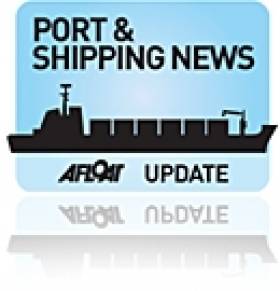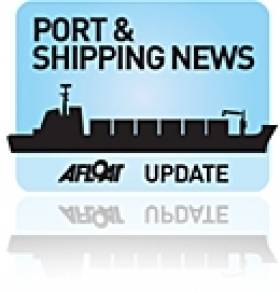Displaying items by tag: Shipping Volumes Up
Shipping Review: Shipping Volumes Up, Tanker’s Tight Squeeze, ESPO to Dublin
#ShippingReview – Over the last fortnight, Jehan Ashmore has reported on the shipping scene as outlined in the following stories below.
Shipping and port activity in the Republic of Ireland rose by 3% in the second quarter of 2015 when compared to the same period of 2014, according to the latest quarter of the iShip Index* published today by the Irish Maritime Development Office (IMDO).
An incredible overhead time-lapse video of the oil tanker Galway Fisher arriving at Galway Harbour recently, showed the skipper’s skills in edging into the tight confines of Dun Aengus Dock.
The European Sea Ports Organisation (ESPO) annual conference will be held in Dublin in 2016. The 13th year of the conferenece will be hosted by the Dublin Port Company and is to take place on 2-3 of June.
#Ports&ShippingReview – Over the last fortnight, Jehan Ashmore has reported on the shipping scene where Irish ports and shipping volumes rose 6% in Q1 of 2015 compared to same period of 2014 according to the Irish Maritime Development Office (IMDO).
EPSO presented its views on Mid-Term review of 2011 White Paper on transport, the organisation said they must feed the review process started by European Commission which should result in "adjustment" or "review" of the strategic document of 2011.
CMA-CGM implements a War Risk Surcharge on all shipments to Hodeidah, Yemen, with charges of US$300 per 20-foot and $600 per 40-foot containers.
Up to €40 million is sought from investors to commit in a major upgrade of Rosslare Europort. The investment will equip the port operated by Iarnród Éireann to handle the ships of the future.
Volumes Up 6% in Irish Ports & Shipping During Q1 2015
#VolumesUp - An increase in volumes of 6% for Irish ports and shipping was recorded in the first quarter of 2015 when compared to the corresponding period of 2014.
The data is according to the latest quarterly iShip Index* published today by the Irish Maritime Development Office (IMDO).
The latest analysis also indicates that all five of the principal freight segments grew in the first quarter of 2015.
The Roll on/Roll off freight segment experienced volume growth of 7% in the first quarter to 233,033 units and is the ninth consecutive quarterly increase in this traffic category. The majority of Roll on/Roll off traffic moves between Ireland and Great Britain and this freight segment is a simple but reliable indicator of the level of trade between both economies.
Container traffic (lift on/lift off) grew by 5% to 156,927 units. Encouragingly container imports have now risen for six consecutive quarters. Container exports, however, fell slightly by 1% to 66,339.
The overall bulk traffic segment saw tonnage volumes increase by 5%, excluding transhipments, when compared to the previous year. Break bulk, which largely consists of imports of construction and project related commodities, increased by 14%. Break bulk has now seen eight consecutive quarterly increases. Liquid bulk also rose by 3%, again excluding transhipments, and dry bulk increased by 6%.
*iShip Index: The iShip index is a volume index for all freight traffic moved to and from the Republic of Ireland. This does not include passengers and transhipment activity.
































































